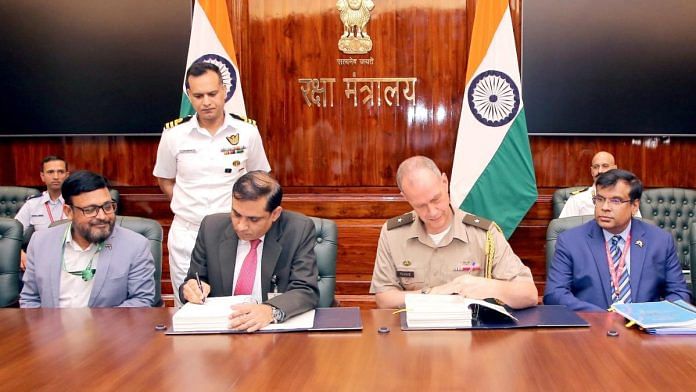New Delhi: Amid China focusing big on its naval prowess way back in 2015, the Indian Navy planners factored in a need for long range unmanned surveillance platforms to keep an almost 24×7 eye on the Indian Ocean Region.
While the Defence Research and Development Organisation (DRDO) was working on unmanned systems, they were catering for Medium Altitude Long Endurance System (MALE), while the Navy wanted high Altitude ones known as HALE.
So, the only option then was to procure from outside. Much to the disadvantage of Indian military planners, there was no system available with anyone to meet such requirements except the Americans.
But the then Obama administration had a freeze on non-treaty partners getting US-made unmanned systems.
The US had used these drones extensively in multiple operations in various conflict theatres like Iraq, Afghanistan and Syria, including to take out high-worth individuals like al-Qaeda leader Ayman al-Zawahiri. And since these unmanned systems were almost exclusive American technology, Washington shied away from sharing it with other countries.
But then came in China. As more and more countries focused on drone technology, China emerged as the world’s biggest exporter of unmanned aerial vehicles (UAVs), including armed versions.
Amid all this and the US seeing China as its future challenger, Washington designated India as a Major Defense Partner (MDP) in 2016, keen to develop a closer relationship.
Also read: Amid concerns about use of Chinese parts in drones, Army general urges industry to be transparent
Negotiations drag on
In 2017, when President Donald Trump came in, he offered to sell the surveillance version of the MQ-9B Sea Guardians to India—an offer that was music to the ears of the Indian Navy.
India thus became the first non-treaty partner to be offered a MTCR Category-1 Unmanned Aerial System—the Sea Guardian UAS, manufactured by American firm General Atomics.
The original plan was to acquire 22 of such drones for the Indian Navy.
However, the Indian Army wanted a bite of the pie too. It was not interested in just the surveillance version but wanted the ones that the US used to take out several terrorists across the world.
The drones come with nine hardpoints, capable of carrying sensors and laser-guided bombs, besides air-to-ground missiles, with a maximum payload of 2 tonnes.
The discussions carried on. Trump, who was keen on getting this mega deal through, decided in 2019 to sweeten the offer by sanctioning sale of the armed drones.
And then India smartly decided to do a tri-service procurement that would have reduced the overall cost and also ensured even distribution from the Services budget.
Since it had first created the proposal for the induction of the HALE drones that allows continuous surveillance of over 40 hours at altitudes of over 40,000 feet, the Navy was made the lead agency even though this was a joint acquisition.
But the cost was too much. The US was unwilling to share any technology or create any kind of infrastructure here.
The negotiations for the drones, which then cost about USD 100 million apiece, dragged on. However, much to the Indian Navy’s joy, an opportunity opened up four years ago when the new Defence Acquisition Procedure 2020 introduced that year allowed leasing of defence equipment.
The Navy then immediately leased two Sea Guardians under emergency procurement.
Interestingly, even though the Navy operates these drones, they have been deployed along the western borders with Pakistan and the northern borders with China depending on the requirements of the other forces.
The Sea Guardian can enable real-time search and patrol above and below the ocean’s surface.
Due to its open architecture system, Sea Guardian operators can integrate sonobuoy management and control system (SMCS) and sonobuoy dispenser system (SDS) that help in tracking submarines.
The erstwhile Trump administration the new Defence Acquisition Procedure 2020 the deal for 30 armed drones to be announced at the two-plus-two ministerial dialogue in New Delhi on 27 October, 2020. However, India did not succumb to the hard American push to seal the deal then.
While the Navy and the Army were fully on board for the deal, the Indian Air Force (IAF), initially, was not.
The IAF’s fear was that too much is being spent on the drones which will take away their funding and government’s focus from the main requirement—fighter planes.
However, finally in 2021, the three Services came together and decided to procure the system, as first reported by ThePrint.
It was in February this year that the US government approved the sale of 31 MQ-9B and related equipment to India for an estimated cost of USD 3.99 billion and notified the Congress.
India had requested the US for 31 MQ-9B Sky Guardian aircraft, 161 Embedded Global Positioning and Inertial Navigation systems, 170 AGM-114R Hellfire missiles, 16 M36E9 Hellfire Captive Air Training Missiles (CATM), 310 GBU-39B/B Laser Small Diameter Bombs (LSDB), and 8 GBU-39B/B LSDB Guided Test Vehicles (GTVs) with live fuzes besides other items for the HALE drones besides logistics support.
The Indian Navy will get 15 MQ9B drones in maritime and anti-submarine warfare kits, while the Army and the IAF will get 8 each of its land version.
The Defence Ministry in a post on X, after signing the contract Monday, said another contract has been signed with General Atomics Global India Pvt Ltd for Performance Based Logistics for these RPAS through Depot Level Maintenance, Repair and Overhaul in India.
(Edited by Zinnia Ray Chaudhuri)
Also read: France’s Safran, frontrunner to power 5th-gen fighter AMCA, expands India operations






